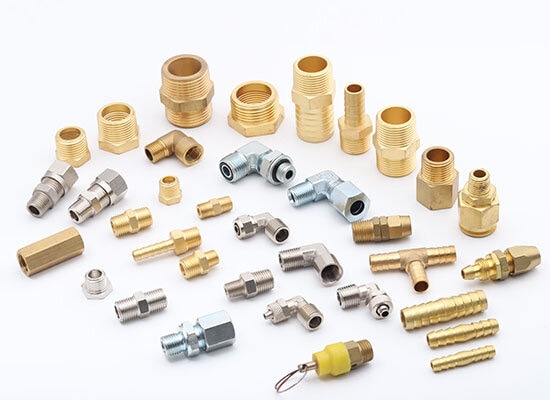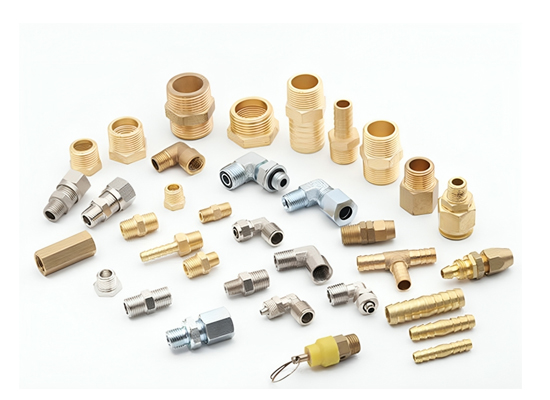Introduction-What Are Pipe Fittings and Why Are They Important?
Modern plumbing and pneumatic systems require a wide variety of pipe fittings, available in many different sizes, materials, and thread types.
Common types of fittings in modern plumbing systems include stainless steel pipe fittings, brass pipe fittings, PVC pipe connectors, and push-fit pipe connectors. Choosing the right material and connection method is critical based on the specific application.
For example, stainless steel fittings and brass fittings are widely used in industrial and construction applications for their corrosion resistance and strength, while PVC pipe connectors are commonly used in lighter, residential systems.
Additionally, using the correct pipe fitting tools ensures the accuracy and stability of pipe connections, reducing the likelihood of leaks and other issues. Whether it's hose pipe connector fittings or pipe connector accessories, the selection should be based on the system's working pressure, material requirements, and connection method to ensure long-term, stable operation.
What Is a Pipe Fitting?
Using the right pipe fitting tools ensures precision and stability in pipe connections, reducing the risk of leaks and system failures.
Types of Pipe Fittings and Connectors
Below are common categories of pipe fittings used in industrial, plumbing, and pneumatic applications:
◆ Brass Fittings And Connectors
◆ Brass Fittings With Nickel Plated
◆ Brass Rapid Fitting With Nickel Plated
◆ Brass Ferrule Compression Fitting
◆ Carbon Steel Connector
◆ Copper Pipe Fitting For Cooling
◆ Others
As a professional pipe connector manufacturer, we are committed to providing customers with high-quality, diversified pipe fitting products and customized solutions to meet the demands of various industrial sectors.
Our products feature a wide range of materials to cover all-scenario needs, advanced technology, superior quality, and extensive product lines. We also offer personalized design, rapid response and delivery, and comprehensive support.
Focusing on technology and customer needs, we provide one-stop services from design to delivery. No matter how complex your requirements are, our professional team and advanced equipment can create satisfactory pipe fitting solutions for you.
What materials are used for pipe fittings?
Pipe fittings, like pipes, are made of various materials. The materials used in the accessories must be compatible with the materials of the pipes they are connected to.
Therefore, accessories are made of many materials similar to pipes. Some of the most common materials used for pipe fittings include brass,
carbon steel, stainless steel, aluminum alloy, and plastic. When selecting materials for your fittings, please ensure that they can handle the temperature,
liquid or gas, and pressure inside the system.
How to choose the right fitting?
When choosing a pipe fitting for your application, you must focus on three details of your pipes: their material、Sizes and Fitting standards
Material
In pipeline system design, ensuring material compatibility between pipe fittings and pipes is critical to system performance and safety.
Following industry best practices, we strongly recommend using pipe fittings made of the same material as the pipes to achieve perfect physical property matching and chemical compatibility.
This same-material design philosophy not only maximizes the system's corrosion resistance and mechanical strength but also effectively extends equipment service life and reduces long-term maintenance costs.
Sizes
In fluid system design, the selection of pipe fitting dimensions is a foundational element ensuring system integrity and functionality.
Precise matching of fitting dimensions is not only a prerequisite for effective sealing but also critical to maintaining system pressure ratings, media flow rates,
and overall operational efficiency. Any dimensional deviation may increase leakage risks, cause pressure loss, or damage equipment, seriously compromising system safety and reliability.
Fitting standards
Pipe fitting standards are determined by a governing body to determine how pipes and fittings join together.
Some of the most common pipe standards include NPT, NPTF, BSPT, BSPP, SAE, UN, and UNF. Because these standards are determined by governing bodies,
they differ based on location. For example, NPT (National Pipe Thread) is the most popular US standard for tapered thread fittings.
BSP (British Standard Pipe), on the other hand, is the popular standard in Great Britain, Australia, and the commonwealth countries.
The standard of fitting you need is determined by the standard of your pipes. When connecting pipes of two different standards,
use an adapter fitting that is suited to your pipes’ respective sizes and standards.
If you have any additional questions, please do not hesitate to contact us.https://www.fescolo.com/pipe-fitting/
















